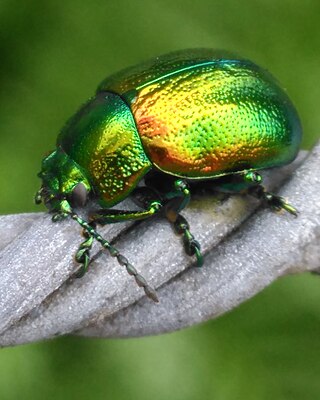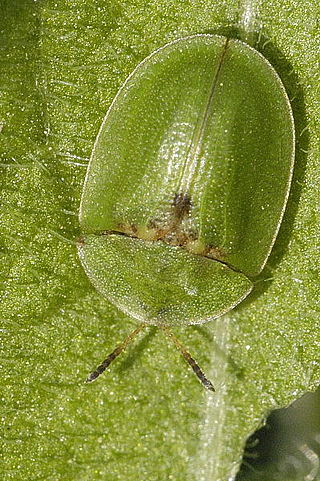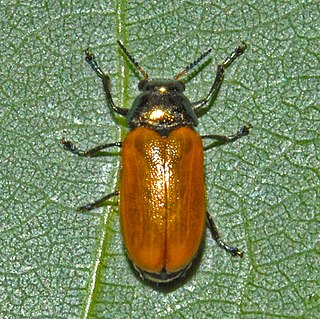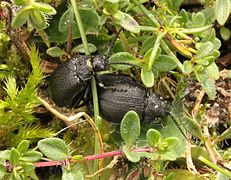
The Colorado potato beetle is also known as the Colorado beetle, the ten-striped spearman, the ten-lined potato beetle, or the potato bug. It is a major pest of potato crops. It is about 10 mm long, with a bright yellow/orange body and five bold brown stripes along the length of each of its elytra. Native to the Rocky Mountains, it spread rapidly in potato crops across America and then Europe from 1859 onwards.

The insects of the beetle family Chrysomelidae are commonly known as leaf beetles, and include over 37,000 species in more than 2,500 genera, making up one of the largest and most commonly encountered of all beetle families. Numerous subfamilies are recognized, but the precise taxonomy and systematics are likely to change with ongoing research.

The tansy beetle is a species of leaf beetle. The common name derives from its main foodplant, Tansy, but it can also use other wetland plants such as Gypsywort and Water Mint. It measures 7.7–10.5 mm in length and has a characteristic bright metallic green colouration, with pitted elytra and a coppery tinge. In addition to the nominotypical subspecies, which repeats the specific name, C. graminis graminis, there are five further distinct subspecies of Tansy beetle, which, collectively, have a Palearctic distribution, although in the majority of countries where it is found the species is declining. In the United Kingdom it is designated as 'Nationally Rare'. The stronghold population here is located along the banks of the river Ouse in York, North Yorkshire. Other, small, fenland populations exist at Woodwalton Fen and at Welney Wildfowl and Wetlands Trust (WWT) reserve.

The scarlet lily beetle, red lily beetle, or lily leaf beetle, is a leaf beetle that eats the leaves, stem, buds, and flowers, of lilies, fritillaries and other members of the family Liliaceae. It lays its eggs most often on Lilium and Fritillaria species. In the absence of Lilium and Fritillaria species, there are fewer eggs laid and the survival rate of eggs and larvae is reduced. It is now a pest in most temperate climates where lilies are cultivated.

Chrysolina cerealis, the rainbow leaf beetle or Snowdon beetle, is a beetle belonging to the family Chrysomelidae.

Xanthogaleruca luteola, commonly known as the elm-leaf beetle, is a beetle species in the family Chrysomelidae that is native to Europe but invasive in other parts of the world.

The thistle tortoise beetle is a species of beetle in the subfamily Cassidinae and the genus Cassida. The thistle tortoise beetle can be recognized by its green, rounded back and it can be found on thistle plants in many regions of North America and Europe. The thistle tortioise beetle was first discovered in 1902 in Lévis, Quebec. In 1931, Nellie F. Paterson was the first to document the mature larva. Later, the instar larva of this species was first recorded in 2004 by Jolanta Świętojańska. The thistle tortoise beetle exhibits multiple defense behaviors, such as a flexible shield, providing a barrier against the mandibles of predators, and an excretion that protects the eggs as well.

Lygus pratensis is a species of plant bug belonging to the family Miridae.

Arima marginata is a species of leaf beetles of the subfamily Galerucinae in the family Chrysomelidae.

Chrysomela populi is a species of broad-shouldered leaf beetle belonging to the family Chrysomelidae, subfamily Chrysomelinae.

Clytra laeviuscula, the ant bag beetle, is a species of short-horned leaf beetles belonging to the family Chrysomelidae, subfamily Cryptocephalinae.

Crioceris duodecimpunctata or the spotted asparagus beetle is a species of shining leaf beetle belonging to the family Chrysomelidae, subfamily Criocerinae.

Cryptocephalus sericeus is a species of beetle of the family Chrysomelidae, subfamily Cryptocephalinae.

Lilioceris merdigera is a species of beetle belonging to the family Chrysomelidae, subfamily Criocerinae.

Clytra quadripunctata is a species of leaf beetle in the subfamily Cryptocephalinae. Its common name is Four spotted leaf beetle.

Cassida viridis, common name green tortoise beetle, is a species of beetle in the leaf beetle family (Chrysomelidae).

Apoderus coryli, the hazel-leaf roller weevil, is a species of leaf-rolling beetles belonging to the family Attelabidae subfamily Attelabinae. Because of the trunk-like elongated head, it is often mistakenly attributed to the weevils.

The milkweed leaf beetle is a species of leaf beetle from the family Chrysomelidae. It is round bodied, 8–11 mm in length with a black head and pronotum and bright orange to yellow elytra with variable mottled black patches. Its colored and shaped like a super-sized ladybird beetle even though the ladybird is in a different family, Coccinellidae. The larva is shaped much like the adult except with a small tail extension. Its color varies from bright orange to white with a gray to black pronotum and prominent black spots around its spiracles.

Lema daturaphila, commonly known as the three-lined potato beetle, is a species of beetle in the family Chrysomelidae. It is originally from Central and North America, but has spread elsewhere.

Labidostomis cyanicornis is a species of short-horned leaf beetles belonging to the family Chrysomelidae, subfamily Cryptocephalinae, tribe Clytrini.























